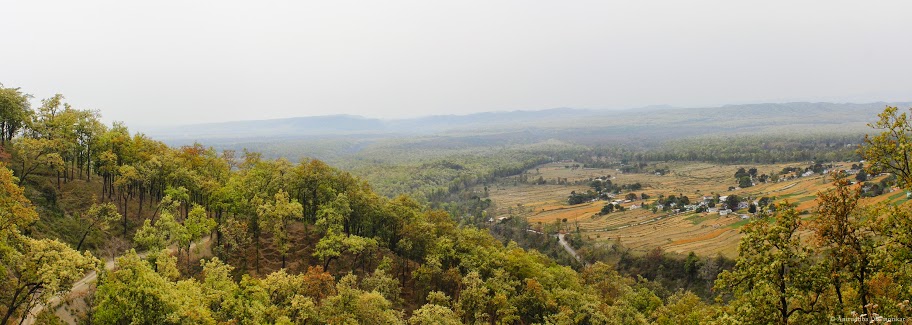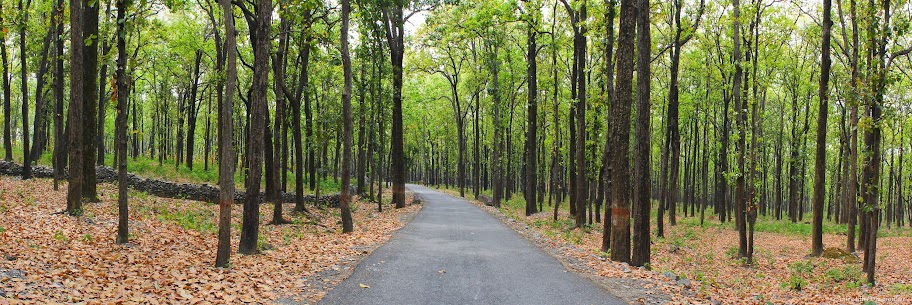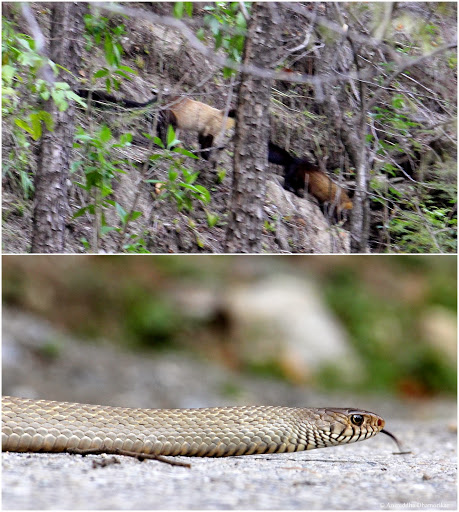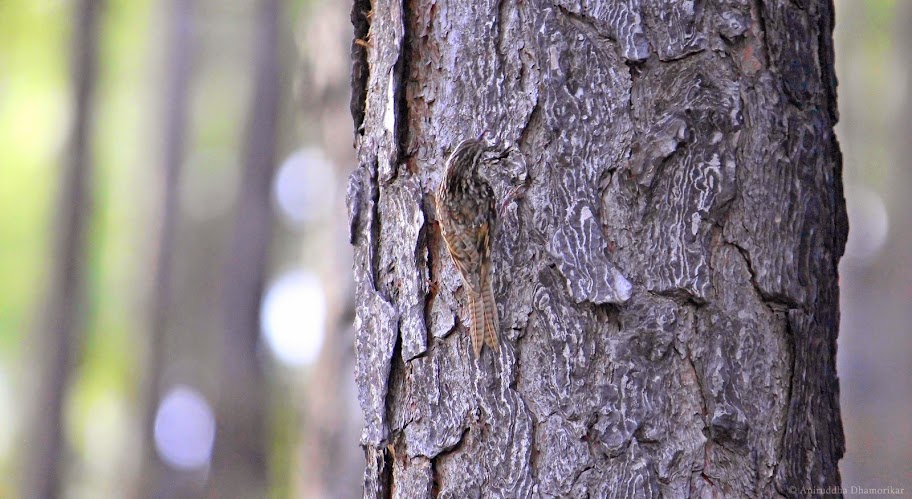The Endless Forest Effect
The road wound around shoulders of a number of mountains,
past terraced fields ripe with wheat, and dived into valleys where bridges
could not be built, and from this mountaintop to that it went, offering vistas
of the Shivalik – the outer mountain range of the Himalaya –, where scars of
landslides are seen everywhere, and only a handful shrubs take hold of the
crumbling crowns of these ancient monuments. We stopped on the arm of a
mountain that protruded into a gentle slope, at the last village on the
mountain, for a meeting and a little ceremony of distributing solar lanterns to
the residents of Amotha, 1290m from the mean sea level.
 |
| Amotha Village lies under the crown of one of the Shivalik mountains |
Standing atop the edge of this Shivalik, I took a deep
breath and inadvertently closed my eyes. The sun shone gently to my east, and a
distant rumble of clouds rolled over beyond the mountain, coming from the way
of the snow-clad Himalaya that lay further north.
 |
| a path cutting through the mountain-side; and a fraction of Amotha's rich biodiversity From top right - Purple Sapphire, Blue Rock Thrush, Pied Bushchat |
Earlier I espied a Purple Sapphire basking on a little herb on
a small landslide south of the village, a Dark Clouded Yellow gliding gently
over a bunch of asters, and a Blue Rock Thrush, Pied Bushchat, and a Himalayan
Bulbul, all singing from their respective perches alongside a narrow path on
the edge of the mountain slope – perhaps of the coming storm, or of the golden
light that changes hues as one approaches, or simply to find a mate to spend
the storm in shelter with.
 |
| Landscape from Amotha Village - the interface between the village boundary and the forests is distinct |
And then I felt something that one feels only when you’re
unbound – that you’re in the right place at the right time – here is where you
were meant to be, and there you were, soaking in the moment with that
realization. And then I saw in a blue tinge as I opened my eyes – the vast
forest stretching southwards for as far and I could see – for eons, if one were
to walk through it.
Only a day ago, I was in the most polluted city of India
trying to find a place to sit before I boarded the train. The traffic across
the street roared from sunrise to sundown. This city lies several hundred miles
south of where I stood on that mountain, and the thought of chocking on
pollution crept over my mind like the storm – dark and menacing – as I stood on
the edge. A foreboding realization loomed over my unbound thoughts, cascading
over the beautiful imagery that my senses helped built, that this forest that
stretches for eons in front of you is actually an illusion – that it is fenced
– that this feeling is nothing but forewarning of the end.
We crept back to where we came from as the sky darkened, and
went down the valley looking at the pale-purple Kachnar flowers, and trees
laden with innumerable orchids, ferns, and a shy pair of Himalayan Goral (Naemorhedus goral), a wild mountain goat.
The Dabka River emerges from these high passes, and flows through the
mysterious forests of Sitavani that is full of myths and legends. From the
mountains the river is seen cloaked in a pale green glow emanating from the
handsome Sal trees in bloom. They resemble little flecks of pale snow, only
that they are scented in the subtlest of fragrance no man can describe.
 |
| Sal trees hugging the large expanse of Dabka River under the shadow of Shivalik Ranges |
The Shivalik foothills are clad in Sal trees, and here you
can see the tallest order of them stretching as far as you can see. It is only
at the edge of wheatfields that you see them finished. Along the shore of the
rivers, they seem to stop, and bow in a gentle curve that appears to be
protecting and praying to the river. In afterthought, they hug the river but do
exactly the opposite with human settlements – they loom if they are not
standing straight, and appear distant and tortured if not angry.
The Dabka River is a small river by local geographical
standards, but its vast shore of pale-pink stone, and its shroud of pale-green
forests harbours a world as the world should be – with Great Indian Hornbills
gliding in its canopies, elephant parades crossing over from the mountain pass,
and leopards and tigers calling this Sita’s forest their abode. If I say that this world is a world as it should be,
it is only here, surrounded by monocultures of rice and wheat, that it exists.
And for most it is considered an unforgiving place to live in.
| A mountain village with terraced fields viewed from Adalikhal |
The life in the mountains is full of struggle, many
maintain. And most who say this have seldom climbed a mountain. Life here is
tough, and in this toughness is born the will to live. The people of the
Himalaya are as much a part of the landscape as the trees and the tiger. Lt.
Col. Edward James Corbett, whose Gurney House in Kaladhungi now remains open as
a museum, recognized this in his hunting sojourns, but he remains celebrated
more for hunting of maneaters and killing of guiltless tigers. The link between
the people and the forest is recognised in Corbett’s My India he wrote after
bidding farewell to India – in its very title – a book he dedicated to the
“simple, honest, brave, loyal, hard-working souls whose daily prayer to God
[...]”, and “[…] people, who are admittedly poor, and who are often described
as ‘India’s starving millions’, among whom I have lived and whom I love […]”.
 |
| The Valley of Mandal River as viewed from Malai Khan, a Van Gujjar Khatta |
In the deep forests on the outer fringe of Corbett Tiger
Reserve, we met Fatima and her sister waiting for the bus – a floral-designed
bandana covered their head, and they shone out like flowers in their pink-and-blue
salwar-kameez. We were travelling from the Sonanadi Wildlife Sanctuary when
Kuber suggested a stopover for a glass of milk on the way to Rathuadhab in the
northern corner of the reserve. Fatima and her sister soon vanished up a steep
slope as we approached and a giant mastiff buff in colour and built barked
relentlessly as if we committed the gravest sin of visiting. He soon received a
slap on his back from Fatima’s sister, and was tied behind the house made of
mud and wood. The house is situated on a small protrusion on the mountain. A
pathway carved by elephants runs barely a few yards from the house. A
corrugated, half-burnt and lifeless solar lantern hangs on the outside of the
window which offers the most spectacular sight of the Mandal River valley, a
river under the shadow of the Garhwal Himalaya. Fatima’s khatta is called Malai Khan, and she is Van Gujjar, the child of
the mountain whose feet are as nimble on the mountains as that of the mountain
goat’s, and her eyes as bright as the morning sun. Her grandmother offered us a
glass of milk thick in cream, and we were soon on our way back just so that the
mastiff would calm down.
Van Gujjar are one of the earliest settlers of these forests
– earliest because no other communities live a semi-nomadic life in this
landscape anymore – and also the most latest – latest because they chose to
live a life in here, surrounded by trees and elephants, and leopards and tiger
that often visit their homes. They ride horses, and trade milk and
milk-products, and maintain cattle numbering in hundreds. Anthropologists,
wildlife biologists, and several other knowledge seekers will tell you tales of
these people, but hardly anyone would tell you that they chose forests over
concrete. In Fatima’s mind, this is the playground, the school, the life to
lead. Her mind knows it, as do her feet. For her, the world is a forest, fenceless
and endless.
| A Greater Yellownape Woodpecker explores the stump of a dead tree for grubs |
I lived with a bunch of wonderful people a few miles from
Malai Khan, in the Valley of Mandal River where it curves and broadens in its
expanse, called Rathuadhab. Ramparts of an old walking bridge stand in the
middle of this gentle river like a gateway to an ancient kingdom. The valley is
cloaked by Sal and Silver Oak, and White-crested Laughing Thrush, Plum-headed
Parakeets, Red-billed Blue Magpies, and Asian Paradise Flycatchers, along with
Himalayan Flameback and Greater Yellow-naped Woodpeckers and a variety of
bulbuls call this forest home.
| A Pied Kingfisher dances in the shadow of Garhwal Himalaya along Mandal River |
Signs of elephants on the road and the valley are common
here, as are Sambar, Barking Deer, and leopards. Life in the river is abundant,
and the River Lapwings, Crested, Pied, White-throated and Small Blue
Kingfishers reign over the waters.
| The endless forests of Garhwal; Sindoori tree in the foreground |
This area is a primary forest with minimal impact of humans.
Except for a little bit of lopping and cutting, the only major human recognition
here is the road. By the measure of the road, I would call it endless as it
seemed to pass through the rich untouched forests far and wide. A visit to the
Mundiapani Forest Rest house said otherwise.
A tree stripped of its bark and bent over itself stands at
the junction of the road that leads towards the rest house. Built in 1903, it
primarily served as a rest house for adventure seekers – mostly elephant-riding
trophy hunters. The house is built on a flat hill surrounded by a small valley,
and is fenced on all the sides using electric wires which are now defunct. Inside
this simple, and the most beautiful, rest house is a book that told me more
about the endlessness of the forest than any man could. I randomly shuffled
through a few pages in the few minutes I spent there. I’m providing below an
excerpt of entries in the guestbook that date back to 1923. I’ve classified them
into three classes based on the year and tone of entries:
[Words in square
brackets are mine]
Class 1: This is when trophy hunting was a prime sport; and
although tigers were the prized catch, species of deer and birds were also
commonly hunted alongside. You will notice a sense of pride or satisfaction
amongst the hunters, either for bagging a kill or for being more-or-less content
with the number of animals shot. The last tiger of this hunting block was shot
somewhere between 1935 and 45.
1935: Shot one tiger measuring 9 feet 9 inch and one female
Sambhar
1935: Thanks very much, shot 1 Kakar [=Barking Deer]
1936: Many grateful thanks. Shot 1 Kakar
1936: Thanks very much for kind permission. Shot Kakars and
pheasant
1945: Thanks for Banglaoo shot only four Kakars and 10 Coocks
only
1946: Shot 3 Kakars and 16 pheasants only [Probably Kalij Pheasants]
Class 2: By early 1950s the tone changes into something more
of disappointment and resentment. This sudden shift is evidently the result of
relentless trophy hunting – one of the major causes of emptying forests by a
rate unmatched by nature’s pace of regeneration.
1959: No shooting
1960: No game
1961: For full 10 days made all the efforts for tiger but
without avail
1962: Hardly a block to consider for shikar [=game/hunt]
Class 3: I could not find the end of Class 2, so I jumped a few
decades and found a complete shift in the attitudes of the people visiting this
rest house. Was it because of the enactment of the Wildlife Protection Act,
1972, or a result of hopelessness in finding shikar? Perhaps it is both, since the Act came into force only when
it was realised that India’s wildlife was being extirpated relentlessly.
1970: Between two jeeps and several hundred kilometers the
total result was 6 pheasants. Neither Sambhar nor Kakar were spotted by me or
any member of my party
1998: October will be disappointing for bird watching for
which we had primarily come
2009: It’s a zero polluted place where there is peaceful
atmosphere created by nature
2009: The place is ossam [awesome],
have a beautiful nature and animals. The feel of the cottage was realy [really] adventurous, But the deficiencies
only of light (electricity) which is essential for the family (children) […] [Signed as] I love nature
| A 1935 entry of the hunt of a tiger and a Sambar by a certain person with his friends |
The shift from Class 1 to 3, spanning 80 years, were
surprisingly distinct. Why was there such marked shift in people’s thinking,
especially of Class 3? Was it because hunting was banned, and that forced
people to take up binoculars and just relax with nature? Was it because they
became so busy earning money in the cities that all they wanted to do here was
relax, and not bother about hunting? – this is remarkably evident in the last
two entries I mentioned above.
Or was it because of an increased awareness amongst people –
enlightenment about ethics and respect for wildlife, or was it simply a
realization that forests and its wildlife are depleting? That it is not
endless?
 |
| The Sal forest on the way to Amotha; near Amgadi |
Forests are viewed as deep and dark places where evil lurks.
This view was especially strong during Colonial India, and thus hunting and
taming of wilderness areas was justified. Corbett’s hunting tales could also be
read on the same lines although he maintained a scientific approach towards
finding out the reason of tigers and leopards becoming maneaters. Perhaps
people were inspired to become hunters after him, and although he played a
crucial role in advocating conservation in his later years, a league of
wilderness tamers was born. Today, the Mundiapani forest has no tigers in it,
although there is no reason why it hasn’t been repopulated again. Perhaps the
scars of ruthless hunting are still fresh, or perhaps the tigers know that it
is a lost ground.
| The map of Corbett Tiger Reserve at the Rathuadhab Forest Rest House |
This is a vast country, and it is only in a handful few
places in India that you will sense the endlessness of the forests. In the back
of my mind, I always think of the cities, and wonder how I ended up there than
here. We drove several hundred miles through Marchula and around Mohan, and
followed Ramganga River to enter the Pauri Garhwal, and on from Palain River to
Lansdowne, through some of the most ethereal Mix-deciduous Sal and Himalayan
subtropical pine forests.
 |
| A pair of Yellow-throated Martens obscured by the thickets; and the Indian Rat Snake that escaped death |
We were to witness a tussle between a pair of
Yellow-throated Martens and an Indian Rat Snake that stood around a bend in the
road, but they were disturbed by the sudden appearance of our vehicle and the
martens went up the hill, and away from our sight. The snake, slowly relaxing, went
in the exact opposite direction – downhill.
 |
| A Himalayan (or Bar-tailed) Treecreeper scampering over the pine tree near Lansdowne (Uttarakhand) |
A pair of Himalayan Treecreeper was out hunting, climbing
and abseiling with ease on the pine trunks. Every time I saw them they had a
little morsel of an insect in their beaks. They are one of the few animals that
live their entire life in these subtropical pines.
 |
| The Chir Pine of the Himalayan Subtropical Pine Forest - the abode of the treecreeper |
The scent of the pines still lingers in my mind, and these
fairy birds dancing in the evening glow of the light, and the cool thin air
that gently touches your skin, and the echoless valleys fill me with awe. What
spell this place has on me I know not. The innate will to be amongst these
trees, where I know I wouldn’t last a few days, surges every time I’m here. This
is not paradise, unless you decide to lock yourself up in a fancy resort in a
quaint tourist town. Attacks of tigers and leopards, and of elephants and other
herbivores raiding crops are, if infrequent, as common as they were during
Corbett’s times. Landslides and men disappearing into the woods never to return
happen here more than on television, and ancient trees sing here songs unsung, if
only you were to listen.
 |
| Terraced mountains overshadowed by the seemingly endless forests |
In this landscape I felt that forests in their entirety will
never vanish, the mountains will protect them, and the rivers will guide them,
but the vastness and endlessness associated with it will. We’re cornering
wilderness without even an idea of what cornered wilderness can do. We only
have a plain idea of what a cornered wolf or a tiger is capable of. We’re
fencing wilderness without even a thought that we’re caging ourselves. And we
live with an illusion that there is still enough for everyone – enough oxygen
and water – the basics of a forest. We’ve created an illusion that our
resources are endless.
We suffer from what I call the Endless Forest Effect.
Interestingly it is not affecting humanity significantly, but has
already affected wildlife.
I stood on the western Shore of Kosi River on the day I
arrived in Corbett Tiger Reserve, and looked on in the dense forests that lie
beyond. A large Indian Flapshell Turtle came to the surface of the water for
air in a circle of Golden Mahseer swimming in the undercurrents. An endless
line of resorts and cottages dotted the shoreline I stood on. A road cut
through the forests a little inland, and further beyond the forests continued over
the hills that would appear to a bystander as an illusionary endless forest.
 |
| The sun rises from behind the heart of Corbett Tiger Reserve's mountains with Kosi River in the foreground |
A century ago, this spot I stood on acted as a corridor for
the wildlife, and especially elephants, to migrate eastwards in the lowlands of
Terai Arc landscape. I imagined parades of elephants crossing the nimble
flowing Kosi, drinking its waters as they passed on, and climbed the last of
the Shivalik hills before reaching the plains.
 |
| A pair of tamed elephants returning tourists after an elephant safari inside the reserve |
And as I gazed into the distance, I saw two tamed elephants
carrying a load of tourists perched atop crossing these waters. Both of them took
a pause in elephant-knee-deep waters to drink through it, and swayed left and
right as they crossed over to the resort-side of the river. They were to stand
by the roadside for another load of tourists to go piggybacking on their backs.
I watched them standing here munching on sugarcane leaves, and I wondered if
they remember their identity – did they remember the sojourns of their
ancestors from the Himalaya to the lowlands? Have they seen their wild cousins
do so?
And I wondered if elephants consider these forests endless.
Why haven't you written any posts on monsoon this year? I thought I would enjoy reading your posts while I wait for it to hit my hometown. Please write (mon)soon.
ReplyDeleteI will be writing soon, finishing off some already-begun works :)
Delete